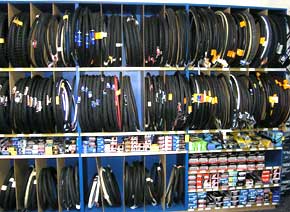All About Bicycle TiresFlat protection, free speed, awesome grip and control, modern tires do it all |
|
|
CLICK THE LINKS BELOW TO JUMP TO THAT PART OF THE ARTICLE |
|||
It's easy to take bicycle tires for granted. After all, with road models there's only about an inch of rubber meeting the road per tire, and only a smidge more even on mountain-bike knobbies and fat cruiser whitewalls. Yet, when you consider that you balance your bicycle on only two wheels at sometimes car-like speeds; that your tires have to grip on rain-slick pavement and muddy backcountry trails; and that they can corner with the fastest wheeled vehicles and climb and descend the steepest pitches, you begin to understand how important it is to have top tires on all your bikes.
While traction, handling and control are essential, tires must also resist punctures; offer good wear; withstand sunshine, ozone and rain; and survive the abuse of striking potholes, debris, steel grates, stones, and in the case of off-road rubber, far worse.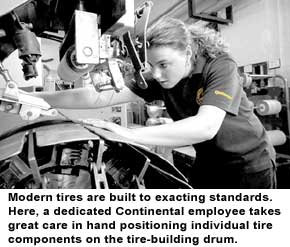
Fortunately, manufacturers have pulled out all the stops to provide excellent bicycle tires for all purposes. From built-in armor for puncture protection to supple casings that conform to the road surface for incredible handling, to dual-compound tread that's durable on top for long wear and sticky on the sides for grip, today's tires offer an impressive array of features and benefits.
To help you understand and choose tires, we've prepared this guide. If you have any questions, please don't hesitate to visit the shop or contact us. We love talking tires!
Why Replace Tires?
There are two primary reasons:
1. The tires you have now are worn out.
2. You're not happy with how your bike rides or handles and you believe new rubber will help.
Identifying Worn-Out Tires
Tires wear out in a variety of ways, but a common sign that they should be replaced is a sudden rash of flat tires — several in a week, for example. This can happen when a tire is worn out because the tread is so thin it can no longer protect the tube from sharp objects you run over.
You can prevent the hassle of frequent flats by checking your tires when they're new so you recognize what good tread looks like. Inspect the depth of the grooves in the tire and then keep an 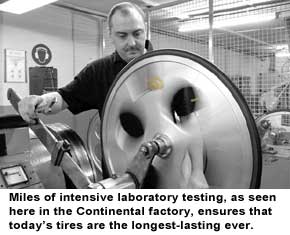 eye on your tread checking before every ride. When the grooves begin to disappear, it's time to replace the tires.
eye on your tread checking before every ride. When the grooves begin to disappear, it's time to replace the tires.
For most road models, this occurs in the range of 1,500 to 3,000 miles for rear tires, which wear much more quickly than fronts because 60% or more of your weight is on that tire (the lighter you are, the longer your tires will wear). Front tires usually run for upwards of 2 to 4,000 miles.
Another sign of wear is squaring off, which is what happens to rear road tires as the top of the tread flattens with many miles. Tires aren't as fast when they've squared off and it's a sign that you need to keep an eye on it and replace it soon.
If you just keep riding on the tire, you'll wear through the tread and expose the threads of the casing beneath it, a sure sign that a new tire is needed. This occurs on front and rear tires if you ride them long enough. At this point, if you continue riding on the tire, you're asking for trouble because the only thing keeping the tube inside is a the thin section of casing, which was not designed to contact the road and will wear much faster than the rubber tread.
Tires wear with age, too. So, if you store a bike for some time, be sure to check the tires carefully. The tread won't have worn because you didn't ride the bike. But, it can harden and crack with age. More seriously, the casing (also called the "sidewall") can rot, crack and delaminate, too. If you see cracks, fraying casing threads and/or rotting, don't ride until you've replaced the tire(s) because while it may hold air, it won't for long and you could suffer a blowout, which can cause a crash.
| Tip: While the tires on a bicycle that's been stored for a month or more will probably be flat or very soft, it doesn't mean you need new tubes or tires. Tubes (which are inside tires and hold the air) lose air naturally over time, so in most cases, assuming the tires haven't decayed, you can simply inflate the tires and the bike will be ready to ride. |
Like road tires, mountain-bike tires are best evaluated by a trained eye based on how much tread they had when they were new. Another gauge is how they ride. As the knobs wear down, traction lessens and you'll feel this on climbs and in the corners. The smaller knobs also mean less protection for the tube, so it can lead to more flats, too. These are signs that it's time for new tires.
Replacing Tires To Improve Ride Quality
Sometimes, you'll want to replace perfectly good tires if they don't ride the way you like. This is a common practice for off-road riders requiring a certain type of ride for the challenges of a particular course. For example, a downhiller uses a different tire than a cross-country rider.
Similarly, if you have heavy, durable tires and tubes on a road bike and you want to keep up with some fast friends, an easy way to make your bike climb, corner and accelerate faster with less effort is to upgrade to lighter tires designed for faster riding.
We're bike-tire experts and if you have any questions about the condition of your tires or whether or not you'll benefit from upgrading to new ones, just ask us and we can make a recommendation.
The Basics
Tire Types
Most bicycles today have tires with tubes inside. The tube is made of rubber, has a valve in it for inflation, and is just the right size and shape to fit inside the tire. When you inflate most tires, you are actually pumping air into the tube inside the tire, which fills the tire. Then, should you suffer a flat, you can simply remove the tire and replace or patch the tube to fix the problem.
The newest technology is found in tubeless tires, which are now available on certain mountain bikes and sometime soon, on road models, too. These tires are similar in design to automobile tires in that there's no tube inside. This works because the tire and rim act as a system to seal the tire and keep the air inside. The advantage of tubeless tires is the ability to run lower pressures with very little risk of flatting, even on extreme terrain. Plus, the softer tires provide more control and a smoother ride. This enhanced ride is complemented by the fact that because there's no tube, the tire is the only thing you feel, which means more compliance and a velvety-smooth ride. While these tires require special repair kits, they are less puncture prone than conventional skins.
The third type of tire, is called a tubular or sew-up. These are specialty tires found on high-end road bikes and designed mainly for racing. They are called tubular because they have a round, tubular 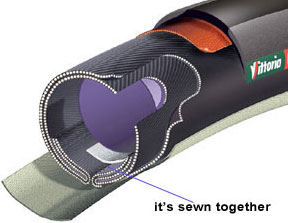 profile. And they're called sew-ups because they're sewn together at the belly of the tube to give them the round profile (illustration).
profile. And they're called sew-ups because they're sewn together at the belly of the tube to give them the round profile (illustration).
There is a tube inside and to fix a flat you must cut the threads, extract the tube, patch the hole and then sew up the tire again! Tubulars require a special rim with a flat surface on top because the tires are glued onto the rims during installation. When you get a flat, you don't repair the tire on the road. You simply peel off the bad tire and install your spare.
The reason racers like tubulars is because their round profile provides a super-supple ride that prevents much of the road shock from reaching the rider. Also, tubular rims and tires are lighter than conventional tires, which means slightly better acceleration, climbing and sprinting. And, because the tires are round, tubulars corner a little better than other racing tires, too.
Tire Sizing
When you need new tires, the first thing to know is what size to get. To determine this, simply look at the side of your tire where you'll find a size marking or a tire label with the tire size on it. Common sizes include 26 x 1.5; 26 x 2.0; 700 x 25c and 27 x 1 1/4.
Write this number down so you can tell us what size you have when you come in to select replacement tires (or if you prefer, simply bring in the old tire with you so we can match its size). The first number (for example, "26" or "700" or "27") indicates the tire and wheel diameter. The second number ("1.5," "2.0," "25c," and "1 1/4") refers to the width of the tire as in 1.5 inches; 2.0 inches; 25mm; and 1 1/4 inches; and so on.
| Tip: Don't be confused by the road bike tire designation "c" as in the size 700 x 25c. The "c" is just a French tire size, it does not stand for a numerical measurement. |
When shopping for tires, you must match diameters, so if you have 26-inch wheels, only 26-inch tires will fit. You can usually change widths if you want, however. And this is a good way to change the ride quality, too. For example, switching from a 26 x 1.5 tire to a 2.0 model puts you on a wider tire that holds more air, which you might like for more comfort, traction and control. Conversely, a roadie might switch from 700 x 28c tires to 23c tires to save a little weight for easier climbing and faster acceleration. While, if you were suffering frequent flats and a rough ride on narrow tires, you'd benefit by switching to wider tires for more protection and comfort
Keep in mind that not all rims and bike frames accept all possible tire widths. Usually going up or down one or two widths will work. If you're considering a big jump up or down, give us a call so we can make sure your rims and frame will accept the change without problems.
Directional Tires
Mountain bike tires are sometimes offered with directional tread. These rear- and front-specific designs offer optimum handling, traction and control based on the different functions the wheels serve. Directional tires are marked to tell you which wheel they belong on and in which direction the tread should be mounted. Assuming you like the way your bike handles, look for these markings before you replace tires so you know which new knobbies to get. And, be sure to install the new tires correctly.
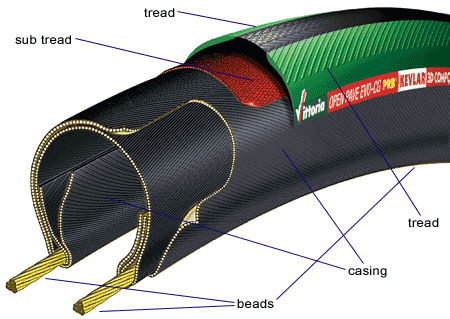
Selecting Tires
The illustration above shows the basic components that make up modern tires. The differences in how tires are constructed determines ride quality and the price range of the tire as the more features it has, the more difficult it is to manufacture. Here's a rundown of the common features with tips on how to choose.
Beads
The beads are the parts of the tire that grip the rim when the tire is inflated to keep the tire in place. At lower price points, tires come with wire beads made of steel. As you spend more, tires feature flexible beads made of synthetic materials, such as Kevlar, a DuPont material also used in bulletproof vests (more about Kevlar later). Tires with flexible beads are called "folding tires" because the beads allow the tire to be folded (wire-bead tires can only be folded partially). They're also called "Kevlar bead tires." Besides saving weight, Kevlar beads usually make tires a bit easier to install and remove, too.
How to choose: If you want the best, get folding tires because they're lighter, which makes your bike easier to ride. If you want a good tire at a sweet price, you can usually get top tire designs for less simply by buying the version with wire beads.
Casing
The casing is the fabric that forms the basic structure of the tire. The material that's used, the number of threads per inch (TPI), and the design affect how a tire feels and handles.
How to choose: As a general rule, the higher the thread count, the more flexible and supple a tire will feel, which improves ride quality, handling and control. It also increases cost. If you're looking for protection from flat tires, some tires have reinforced sidewalls designed to help prevent punctures.
Sub-Tread
Not all tires have sub-treads. They're a common feature on tires designed with additional puncture protection. For example, an additional Kevlar or nylon layer will be placed in the tire beneath the tread to stop sharp objects from being able to puncture the tube. Tires equipped with protective sub-treads will be labeled as such.
How to choose: If you suffer lots of flats due to the roads or conditions you ride in, getting tires with protective sub treads makes a lot of sense. Ditto if you only puncture occasionally, but hate dealing with flats. The only drawback is a little additional weight, which racers and fast riders might not want.
| Tip: Getting the right tires will go a long ways towards preventing flats. We also offer tubes and accessories to protect you from punctures, plus tools to make the occasional repair as easy as possible. If flat tires are ruining your cycling experience please give us a call. We can help! |
Tread
The tread is the rubber that meets the road or trail. On road tires more tread usually means increased wear along with additional weight, so it's a tradeoff whether you require top ride quality or durability. Road tread varies in hardness, too, with harder rubbers wearing longer while softer compounds grip better in corners. These are fine distinctions widely debated among riders. You'll even find tires with dual-compound tread designed for good wear and top traction. And tread specifically designed for wet roads, as well.
For off-road riding, the amount of tread and the pattern of the tread determine the ride quality, traction and control. Manufacturers strive to design tread that provides the exact handling and characteristics for the different types of off-road terrain, riding and conditions. For example, if you ride in the mud and snow, there are tires designed specifically for these conditions.
How to choose: What's best has mostly to do with how and where you ride so if you can tell us that, we can point out some of our most popular tires for different types of riding. Another way to determine which tires are right is to ask friends you ride with who may have found models they recommend.
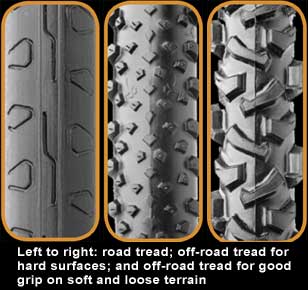
We hope these tips help and we look forward to seeing you when need new tires!
Special thanks to BikeMine, Continental and Vittoria Tires for supplying the great pictures.

